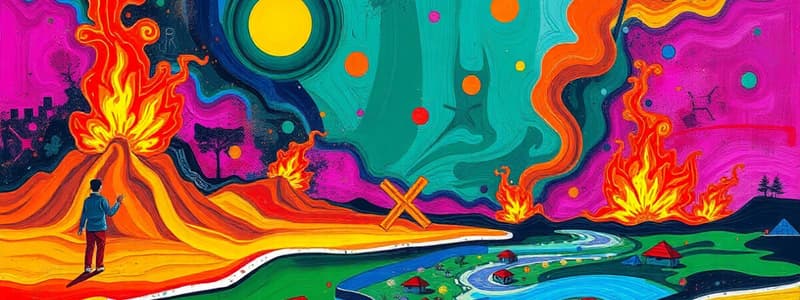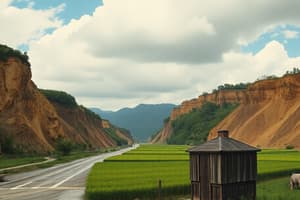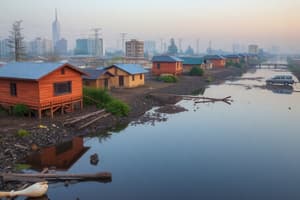Podcast
Questions and Answers
Which human activity directly contributes to environmental degradation?
Which human activity directly contributes to environmental degradation?
- Conservation of natural resources through recycling programs
- Construction of infrastructure that alters natural landscapes (correct)
- Reforestation efforts in deforested areas
- Implementation of sustainable agricultural practices
A nation-state is defined by multiple peoples living within clearly defined borders.
A nation-state is defined by multiple peoples living within clearly defined borders.
False (B)
What term describes the movement of cultural elements from one region to another?
What term describes the movement of cultural elements from one region to another?
Diffusion
The sector of the economy that involves taking raw materials directly from the environment is known as the ______ sector.
The sector of the economy that involves taking raw materials directly from the environment is known as the ______ sector.
Match each economic sector with its description.
Match each economic sector with its description.
Which of the following best describes the role of 'capital' as a means of production?
Which of the following best describes the role of 'capital' as a means of production?
Surface mining involves extracting minerals from deep underground.
Surface mining involves extracting minerals from deep underground.
What is the term for a border between countries that follows a natural feature such as a river or mountain range?
What is the term for a border between countries that follows a natural feature such as a river or mountain range?
The area of shallow water adjacent to a continent that belongs to that country is called the ______.
The area of shallow water adjacent to a continent that belongs to that country is called the ______.
Which type of pollution is directly caused by the emission of carbon dioxide from burning fossil fuels?
Which type of pollution is directly caused by the emission of carbon dioxide from burning fossil fuels?
Flashcards
Environmental Disaster
Environmental Disaster
Disasters caused by human actions affecting the natural environment.
Air Pollution
Air Pollution
The contamination of air by harmful gases, often from burning fossil fuels.
Acid Rain
Acid Rain
Rain containing acids formed from pollutants in the atmosphere.
Sovereign State
Sovereign State
Signup and view all the flashcards
Natural Border
Natural Border
Signup and view all the flashcards
People (Cultural)
People (Cultural)
Signup and view all the flashcards
Culture
Culture
Signup and view all the flashcards
Diffusion (Cultural)
Diffusion (Cultural)
Signup and view all the flashcards
Mining
Mining
Signup and view all the flashcards
Labor
Labor
Signup and view all the flashcards
Study Notes
- Environmental disasters are caused by people affecting their natural surroundings.
- Natural disasters are caused by nature.
Environmental Problems
- Environmental pollution: Using the environment as a place to dump waste.
- Environmental exhaustion: Depletion of natural resources.
- Environmental degradation: Human changes to nature and landscapes.
Types of Environmental Pollution
- Air pollution: Introduction of polluting gases into the atmosphere, often from burning fossil fuels, including carbon dioxide emissions.
- Acid rain: When acidic substances fall to the ground
- Water pollution: Discharge of toxic substances into surface water.
- Soil pollution: Contamination of the ground with harmful substances; cleaning polluted soil is called soil remediation.
Borders and States
- A state is a region with defined borders and its own government.
- Netherlands is a sovereign state managing its own affairs.
- A natural border follows a natural obstacle.
- An artificial border is marked by signs and boundary posts.
- Continental shelf: The area of shallow water around a continent that belongs to the country.
People, Culture and Nation
- A people is a group of humans sharing the same culture, having lived together for centuries.
- A nation is when a state consists of only one people, also known as a nation-state.
- Culture includes the beliefs and customs learned while growing up.
- Spatial planning elements can reflect culture.
- There are seven cultural regions worldwide with similar cultural elements.
- Diffusion: The spread of cultural elements from one region to another.
Economic Sectors
- Primary sector: Extraction of raw materials from nature (agriculture, fishing, mining).
- Secondary sector: Manufacturing; processing raw materials into finished products.
- Tertiary sector: Businesses providing services.
Means of Production
- Labour: Paid work producing goods or services in all sectors.
- Working population are those with paid work and those seeking work.
- Capital: Buildings, machinery, equipment, vehicles used for production.
- Natural resources: Elements from the natural environment needed for production.
Raw Materials
- Raw materials are used at the start of the production process.
- Unprocessed raw materials: Come directly from the primary sector.
- Minerals: Resources extracted from the earth through mining.
- Surface mining: Extracting minerals from the surface.
- Subsurface mining: Extracting minerals from underground.
- Semi-manufactured products: Products already processed by industries.
Service Sectors
- Commercial services: Part of the tertiary sector.
- Non-commercial services: Part of the quaternary sector, largely government-employed.
Service Sector Considerations
- Developed countries: Service sector employs about 75% of the workforce, with well-paid, highly educated workers.
- Developing countries: Service sector workers are often uneducated and low-paid.
Studying That Suits You
Use AI to generate personalized quizzes and flashcards to suit your learning preferences.




